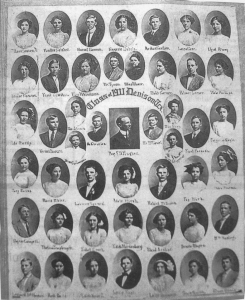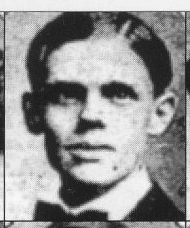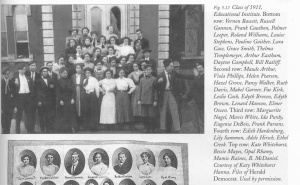Maude Arthur
Posted: February 11th, 2015 | Author: Matt | Filed under: personal | Tags: Arthur, Denison, DHS, family, Freemasonry, history, MarieArthur, MaudeArthur, MKT, tuberculosis, YellowJacket | 2 Comments »There is a deep human need to be remembered. Most of humanity is forgotten, of course. Many, many people who were successful or beloved or wildly popular are forgotten a generation later. I’ve always been fascinated by books or projects that go back and resurrect a forgotten life and remind us that we have giant gaps in our knowledge of the past. One example is Alain Corbin’s The Life of an Unknown where he picks a name at random from a 19th Century civil registry and researches the history of that particular person as deep and wide as he can. Corbin isn’t writing an academic microhistory there, but actually trying to repair holes in our collective memory.
In previous posts on Robert T. Arthur, I was curious about how his daughter, Maude (above), died so young. She was only 23 when she died in 1916. After reading more about her life, I feel like I have discovered a remarkable person.
By all accounts, Maude had the trademark personality of a first born child: a leader, smart, willing to please. But tragedy struck her young family when she was 4 years old. Her baby sister, Lenora Fay, only 22 months old, died while the family was in Fort Scott, Kansas. (I’m not sure if Maude was also born in Fort Scott or if this was just a brief stay in Kansas. Like Denison, Fort Scott was a Katy Railroad stop and it’s likely he was on assignment there.) No doubt Maude carried some of her parents’ burden over that unforgettable tragedy throughout her life. Her parents did have another child, another girl, Marie, in 1902 when Maude was already 10. The difference in ages meant they were not likely as close as they would have liked to be. When Marie was ten years old, Maude had already graduated high school.
In high school, Maude was at the center of the social world. The Denison High School class of 1911 was small, but Maude stood out. In her junior year she was the Society Editor of the Denison High School Yellow Jacket (the yearbook which also published newsletters at the time). She was also an aspiring writer. Here is a story she contributed to the Christmas 1910 Yellow Jacket. (I transcribed it below.) I think the story displays incredible maturity for an 18 year-old girl and a real ability at crafting stories.
The Bernhardts Christmas Gift
By Maude Arthur
The cottage homes of the Bernhardts stood side by side in exact duplicate with the hanging baskets on the porch and the well laid off vegetable garden in the rear. So was the relation of the families. But of late the Mesdames Bernhardts, who had always begun and ended their house-cleaning seasons on the same day, whose preserves and jellies tallied to a jar and who made their patchwork quilts from the same pattern, had gotten in the habit of shaking their heads and lamenting that Herman and August were not happy any more spending their days in making their compounds or sitting on the green bench in the evenings smoking their long-stemmed pipes. Nowadays the men spent all their time in their laboratory, which stretched along the end of the two yards, and worked in bad smelling messes and evil looking mixtures. “And no good would come of this,” said Mena to Lena.
When the cousins took in a partner, a shock-headed young man with a queer uncatchable eye that never looked straight at anyone, Mena said it was nothing than the doings of the unsound minds of the cousins; for outside of this, August, her husband, had talked recently in his sleep about a “solution” that would bring him wealth beyond measure. When questioned about it, he became angry, but finally told her that he had come upon a combination of certain liquids that lacked but one ingredient to make a substance from which the most beautiful jewels could be made. This one ingredient he would find then hey for fame. He said that Herman had helped a little, but only a very little, the idea was his, August’s and the fame would be given him when the time came.
Lena also questioned her husband about the wonderful discovery, Herman seemingly informed her that the fame belonged to him and that August was only helping him. However, she would see when the missing link was found who would get the glory. The new partner who was experienced in chemical matters had been taken on to assist in the detail work and to help along the research for the last ingredient.
Then the lives of the two fraus became miserable, for they loved their husbands dearly and they loved each other dearly. They now foresaw the troublesome times ahead. The breach between the two families soon widened; both Herman and August became cross and sullen toward each other and each bade his wife not to visit or have anything to say to the wife of the other. Sorrow and dismay descended on the good wives, whose stolen interviews could not bring much comfort since Herman and August were at the point of blows.
One morning a fearful shock came to August and Mena; during the night Herman had stolen away taking with him his wife, the rascally new partner, and all of the precious discovery.
Up and down the white-colored kitchen raged the cheated cousin, wrenching his gray hair into wild disorder and bidding Mena hold her tongue when she tried to comfort him. Then his mood changed and he vowed to find his tricky kinsman, though it cost him years of life and hundreds of dollars, and wrest from him the magic compound which he had stolen. This was a vast undertaking. Herman’s house had been shut up, and no one could be found who was able to throw any light on the subject.
Soon August prepared to leave on his strange quest. The cottage was locked up, the cat given to a neighbor, and Mena beheld but a quivering mist as, with tear-blurred eyes, she bade farewell to her beloved cabbage garden.
Then followed the long, dreary pilgrimage of the aged couple. Now and then vague tidings of Herman’s movements came to them, but finally giving up all hope of finding his cousin, he settled in a little cottage far distant from his old home and fitted up a miniature laboratory where he worked day and night to duplicate the priceless mixture which had been stolen from him. But it was useless as he’d forgotten the very ingredients as well as the details of the process.
Mena, worn out with the long and fruitless search, was glad to have some scrubbing, washing, and something to do. August, who was so low in spring, would help her in nothing, so the poor soul was obliged to potter around with her pantry-shelves, her newly sorted window plants and such balm-giving occupations. It was a good day for her when she discovered a curious closet under the stair with a ….. like this paneling that therefore she had overlooked it. Then she bought her…. (If you’d like to read the rest of the story, please click here: http://www.rootsweb.ancestry.com/~txgrayso/GatheredTogether/SCHOOL/SCHOOLS/DenisonHighSchool/DHSHistory/1910YJ_Xmas/1910Xmas_4.html
—-
Some context about this story: Denison High School had recently built a chemistry lab on campus. It was considered the height of sophistication and scientific advancement. Marie Curie was all over the newspapers then, having won the 1903 Nobel Prize in physics (she would also win the 1911 Nobel Prize in chemistry). The women’s suffrage movement was acquiring an air of inevitability and progressive young women, like Maude, were looking to do more than study home economics.
During Maude’s high school years, the Arthur family lived at 1030 W. Sears St. in Denison (they had moved from 700 W. Owings St., and in later years the Arthur family lived at 1023 W. Morton).
It was at this house where Maude hosted the high school class for a Halloween party, which she described in her society column in the 1910 Yellow Jacket.
[Maude’s boyfriend was Leslie Cash, on the bottom row here, in the center, with the dark suit. He’s also the “One Who Loved Her” who wrote the tribute to her, below.]
Maude
Leslie Cash
(These photos are terrible quality-wise but they are all I have found so far.)
Leslie Cash later moved to Oklahoma and married a woman named Glennis. Their son, Robert, was born in 1924 and served in World War II. He passed away in 2013, but his experience as a prisoner of war in Europe is quite incredible:
He trained as a radio operator and top turret gunner on the B-24 Liberator. He was with the 8th Air Force, 492nd Bomb Group, based in Norwich, England. He was privileged to fly on D-Day, June 6, 1944. Two weeks later, on his 13th mission, his aircraft was shot down over the Baltic Sea. Bob was badly burned and wounded. He bailed from the burning plane, was rescued by German Marines and classified as a POW. At the time, he didn’t know it, but Bob was the sole survivor of a crew of 10 men. Not a day in his life went by without remembrance of those crewmen. He spent more than 10 months as a POW, living on quarter rations. On Feb. 6, 1945, they struck out in the snow for what they were told was a 16-day march that ended 90 days and 800 miles later from the starting point. It was aptly named “The German Death March,” as some 2,500 POWs perished on that march. The British 11th Armored Division, one week before peace was declared in Europe, mercifully liberated them.
Alas, she didn’t survive. Maude L. Arthur died in San Angelo, Texas, at the age of 23.
(As before, I am transcribing these newspaper articles so that the text may be searchable.)
Denison Daily Herald, January 8, 1916
Popular Denison Girl Dies in San Angelo
A message received in Denison this morning from San Angelo conveyed the sad news of the death of Miss Maude Arthur, the daughter of Mr. and Mrs. R. T. Arthur.
Death occurred at 9:30 a.m. today. Mr. Arthur, who is a passenger conductor for the Katy, and the youngest daughter, Marie, who is attending the public schools in Denison this winter, left the city at an early hour this morning for San Angelo in response to a message stating that the condition of Miss Maude was very critical. They will not reach San Angelo until tonight. Mrs. Arthur was with her daughter when death came.
The remains, accompanied by the family, will leave San Angelo Sunday morning and are expected to arrive in Denison Monday morning. No definite word as to the funeral arrangements have reached here as yet.
Too many words of love and commendation cannot be spoken of Maude, who was universally loved in Denison. She was a member of the Denison High school class of 1911, and was a member and faithful worker in the First Presbyterian church of this city. The memory of the many charitable acts of kindness and her sweet and lovable ways will dwell forever in the hearts and minds of all those with whom she was associated in any way. Her life was one of purity, filled with the love of true friends.
Owing to the impaired condition of the deceased’s health, the Arthur family left Denison about two years ago, going to San Angelo, in the hopes that the change of climate would be of material benefit to her, but all was done that the mortal hands could do, and “He who doeth all things well” called her home.]
[Denison Daily Herald, January 10, 1916
Hundreds Paid Last Tribute to Miss Arthur
Hundreds of sorrowing friends, including many out-of-town residents, gathered at the First Presbyterian church at 3 o’clock this afternoon to pay their last respects to Maude Lorene Arthur, the daughter of Mr. and Mrs. R. T. Arthur, whose death occurred at 9:30 o’clock Saturday morning at San Angelo.
The remains, accompanied by the parents, the sister, Marie, and Leslie Cash of Denison, who accompanied Mr. Arthur and Marie to San Angelo Saturday morning and Mrs. W. P. Hulen and Mrs. Joe Davis, who met the party in Dallas, arrived in the city on the Katy Flyer this morning. Many friends of the family met the body at the depot and accompanied it to the Presbyterian church, where it lay in state, until the funeral service at 3 p.m. Interment was made in Fairview cemetery.
Among the societies who attended the funeral in bodies were the Madge Waples Circle of the Presbyterian church, the As You Like It club and the class of 1911 of the Denison High school, all of which Maude was a member until she let Denison about two years ago. Maude was one of whom her associates can truly say “she was a friend,” always ready to lend her assistance in any way.
The services were simple and impressive and were conducted by Rev. J.E. Aubrey. As the family entered the church the choir sang softly and sweetly “Lead Kindly Light.” This was followed by hymns, “It Is Well With My Soul,” “Asleep in Jesus,” and “Home of the Soul.” The recessional sung by the choir was “Nearer My God To Thee.”
Floral offerings of every design covered the mound at Fairview, speaking in a small way of the love and friendship cherished by the host of deeply grieved friends. The conductor organizations and railway offices of almost every station both on the North and South end of the Katy sent beautiful flowers in wreaths and bouquets.
The session of the First Presbyterian church acted as pall bearers.
Among the out-of-town friends who attended the funeral were: D.S. Mcmillan of Whitewright, Mr. and Mrs. Tee Johnson, Mr. and Mrs. M.S. Barton, Mrs. A.F. Henning of Dallas; Mrs. C.M. Stone and daughter, Miss Alta, of Parsons, Kas.; J.R. Kramer of Hillsboro.]
Researching all of this about Maude has deeply affected me. I have given great consideration to the fact that Maude Arthur has not walked this earth in almost 100 years but her headstone remains in near-perfect condition. I have considered how advances in medicine and transportation have changed our ability to prolong life over the course of a century. I have pondered the nature of success and accomplishment and how little of it truly endures, mostly due to the whims of an uncontrollable fate.
Rest in peace, Maude.















I found this fascinating and enjoyed reading about this young lady and her family. Great research on your part Matt.
Very well done, Matt. I’m impressed with how thorough you’ve been in pursuit of this story. It’s a good illustration of how an inquiry into the life of one person can lead you to someone else who is equally or more interesting. Captivating reading.